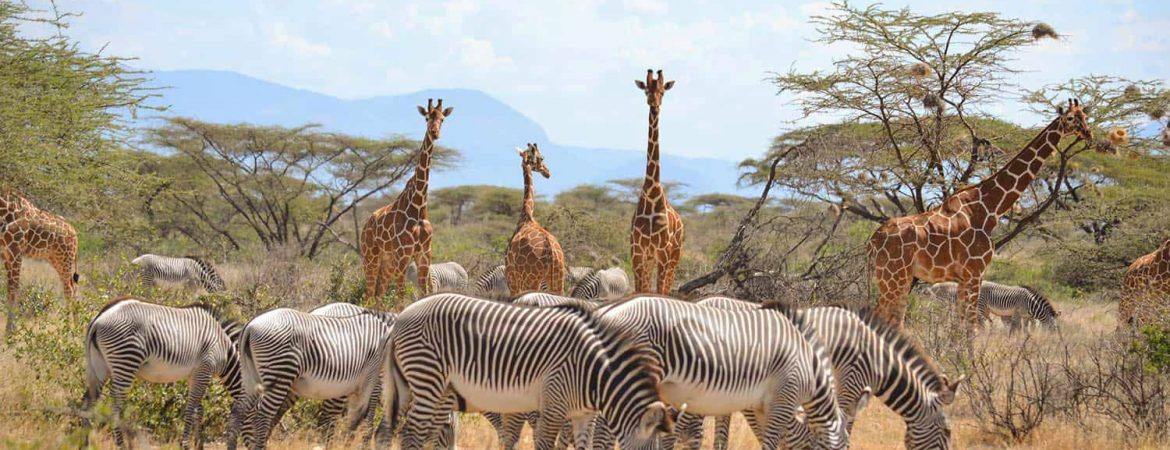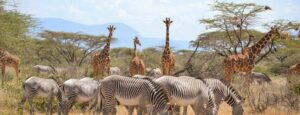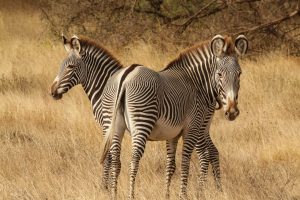
Far from the bustling crowds of Kenya’s southern safari circuit lies a land that feels almost untouched—a place of dramatic landscapes, red earth, and quiet mystery. This is Samburu, a semi-arid region in northern Kenya where wildlife has evolved in unique ways to survive and thrive. Here, the classic “Big Five” take a step back, and a new group of stars emerges.
Known as the Samburu Special Five, these animals are rare, region-specific, and a must-see for any wildlife lover or conservation enthusiast. So, what makes them so special? Each species in the Samburu Special Five is uniquely adapted to this dry and rugged terrain. Some are endangered, others rarely seen outside this region, and all are stunning examples of evolutionary artistry. Let’s meet them:
🦒 1. Reticulated Giraffe
One of the most striking giraffes in the world, the reticulated giraffe is named for its beautiful coat—deep orange patches outlined with crisp white lines, creating a perfect net-like pattern. Unlike its cousins in the south, this giraffe is found primarily in northern Kenya and parts of Somalia. Despite its grace and beauty, the reticulated giraffe is vulnerable, with populations declining due to habitat loss and poaching. In Samburu, though, they’re a common and magical sight, often gliding across the open plains in small family groups.

🦓 2. Grevy’s Zebra
The Grevy’s zebra is the largest and most endangered of all zebra species. With narrower stripes, larger ears, and a white belly, it stands apart from the more common plains zebra. Grevy’s zebras are also known for their independence—they often live solitary lives or in small groups, unlike their more social relatives. Less than 3,000 remain in the wild, making Samburu one of the last strongholds for this extraordinary species.

3. Gerenuk
Delicate, strange, and unforgettable, the gerenuk—often called the “giraffe gazelle”—is a long-necked antelope that stands upright on its hind legs to browse leaves from tall shrubs. With its slim frame, large eyes, and curious feeding style, it looks almost alien at first glance. Gerenuks are shy and elusive, often seen alone or in small groups, blending easily into Samburu’s dry bushland.
4. Beisa Oryx
The Beisa oryx is a desert antelope built for survival. With long, spear-like horns, a strong body, and facial markings that resemble war paint, it’s both beautiful and battle-ready. These animals can survive in extreme heat with very little water—an incredible adaptation to the arid Samburu landscape. Their stoic presence and striking look give them an almost mythical air.
5. Somali Ostrich
Last but not least, the Somali ostrich—a bold and majestic bird, distinguished by its grey-blue neck and legs. Larger than the common ostrich, this bird is powerful, fast, and uniquely adapted to the northern Kenyan ecosystem. Though flightless, the Somali ostrich is far from helpless. It can sprint at incredible speeds and defend itself with powerful kicks. In the open scrub of Samburu, it’s both a sentinel and a symbol of strength.
Conclusion: More Than Just Wildlife
The Samburu Special Five are more than rare animals, they’re symbols of a wild, beautiful ecosystem that’s often overlooked. They remind us that nature holds endless diversity beyond the spotlight. And that sometimes, the most powerful stories are whispered in the quiet corners of the world.
As we begin this journey into their lives, habits, and habitats, may it open your eyes to the unique magic of northern Kenya and the importance of protecting it.
Whether you’re a wildlife enthusiast, a curious traveler, or someone who simply loves a good story from the wild, there’s something in Samburu for you.
